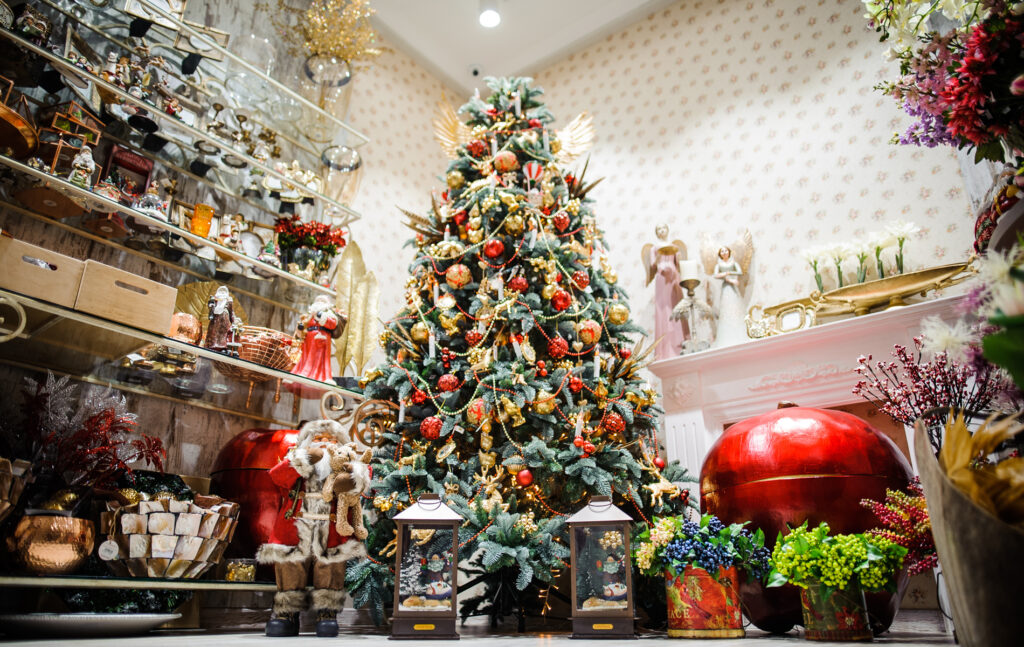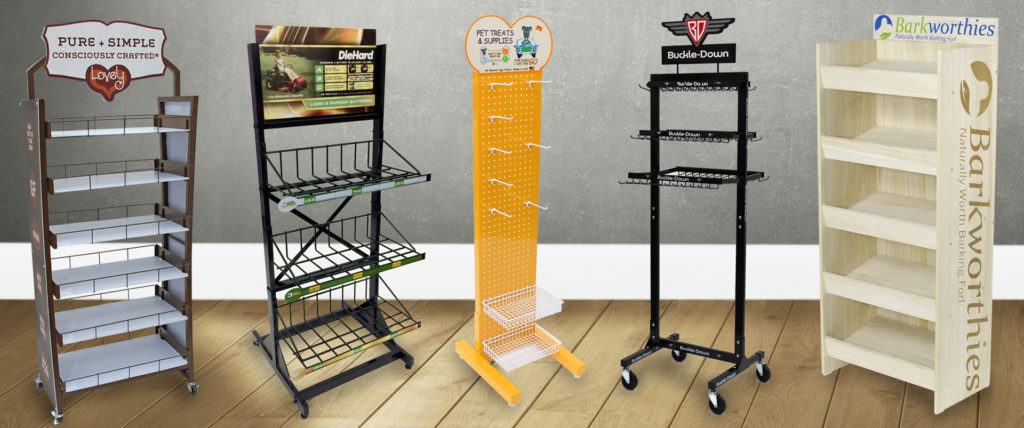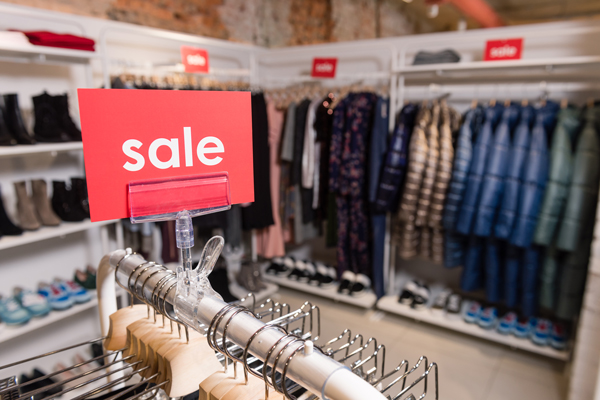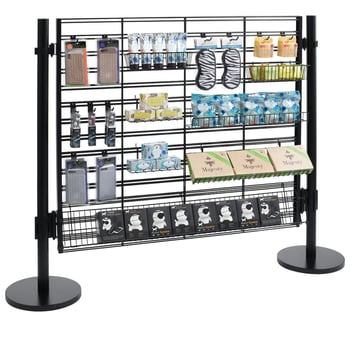
The holiday shopping rush is your biggest sales opportunity of the year. The National Retail Federation reports massive sales figures annually, showing just how ready customers are to spend. While shoppers often walk in with a list, their final decisions happen right on your sales floor. This is where a thoughtful strategy for Point of Purchase Displays During Holiday Season makes all the difference. These displays are your final chance to connect with a customer, turning a planned trip into a bigger, more profitable sale by capturing those crucial impulse buys.
How Point of Purchase Displays Drive Holiday Sales
The (P.O.P) point of purchase product displays are designed to catch consumers when they’re already on the way to making a purchase, offering discounts and deals that require us to spend only a fraction of what they’ve already got in our shopping cart. Even if they had no intention of buying extra items, the power of persuasion associated with impulse displays can crumble their willpower and cause them to throw last-minute items in the cart on the way to the checkout.
The Power of In-Store Decisions
It might surprise you just how many purchasing decisions are made right inside a store. Even with all the online research customers do beforehand, about 73% of shoppers make their final choice while browsing the aisles. This means the physical retail environment is often the final, most influential touchpoint in a customer's journey. For retailers, this presents a massive opportunity to guide those on-the-spot decisions. The layout of your store and the appeal of your displays can be the deciding factor that turns a browser into a buyer, which is why putting an emphasis on thoughtful design and engineering for your fixtures is so important.
Key Holiday Shopping Statistics
The holiday shopping rush amplifies this in-store influence even more. Shoppers are already in a festive, spending mood, and research shows that impulse buys are incredibly common. Around 62% of shoppers make impulse purchases, with 16% of those unplanned buys being directly driven by promotions and displays they see in the store. This underscores just how effective a well-placed POP display can be for capturing last-minute sales and introducing customers to new products they'll love. When you consider that holiday retail sales consistently generate hundreds of billions of dollars, capitalizing on even a small fraction of that impulse spending can make a significant impact on your end-of-year results.
Maximize Your Impact as a Retailer
Retailers naturally want to harness this phenomenon in their own stores, especially after the holidays when they have a leftover product to move, and shoppers are less inclined to spend. How can you use the power and glory of point-of-purchase displays to your best advantage to clear out inventory after the holidays? We break it down in our guide, "Driving Post-Holiday Sales."
Let's break it down here too. To make the most of your store's environment to boost sales, consider the following.
Choosing the Right Type of POP Display
Not all POP displays are created equal, and the right choice depends entirely on your campaign goals, product type, and budget. Are you running a short-term seasonal promotion, or are you building a long-term brand presence in a retail space? The answer will guide your decision between a temporary fixture that’s quick and cost-effective or a permanent one designed to last. Understanding the fundamental differences is the first step in creating a display that not only looks great but also performs well. This choice influences everything from material and manufacturing to logistics and installation, so it’s important to get it right from the start.
Temporary vs. Permanent Displays
Temporary displays are the sprinters of the retail world. Typically made from materials like cardboard, they are designed for short-term use—usually a few months at most. They are perfect for seasonal promotions, new product launches, or special sales because they are relatively inexpensive and quick to produce. Plus, they are often easy to recycle once the campaign is over. On the other hand, permanent displays are the marathon runners. Constructed from durable materials like wood, metal, or acrylic, these fixtures are built to last for years. They are an excellent investment for establishing a consistent brand presence and showcasing core products that aren't going anywhere. The right partner can help you through the design and engineering process to select materials that align with your goals and budget.
Common Display Formats to Consider
Once you’ve decided between a temporary or permanent fixture, the next step is to select the right format. The physical shape and placement of your display are critical to its success. Different formats are designed to work in specific areas of a store, from the main aisles to the checkout counter. Each one serves a unique purpose, whether it’s to move bulk inventory, encourage an impulse buy, or simply make your product stand out on a crowded shelf. Let’s look at some of the most effective and widely used display formats that can help you capture customer attention and drive sales.
Floor and Pallet Displays
Floor displays are freestanding fixtures that command attention in open spaces or at the end of aisles. Because they stand alone, they can be designed with unique shapes and graphics that draw shoppers in from a distance. They often position products at eye level, which is a proven way to increase sales. Pallet displays are a larger version of this concept, often used to merchandise a high volume of a single product. They are typically shipped pre-packed and are great for big-box retailers looking to move a lot of inventory quickly, especially during high-traffic periods like the holidays.
Endcaps and Sidekicks
Endcaps are prime real estate in any retail store. These displays are positioned at the end of the aisles, where they are highly visible to nearly every shopper. This placement is so effective that customers often assume products featured on an endcap are on sale, making them more likely to make a purchase. Sidekicks, also known as power wings, are smaller displays that hang on the side of an endcap or other shelving. They are an excellent way to cross-merchandise related items or feature smaller products that might otherwise get lost on the main shelf.
Counter Units and Display Bins
Counter displays are small but mighty. Placed directly on checkout counters, they are perfectly positioned to capture last-minute, impulse purchases. Think of items like candy, gum, gift cards, or travel-sized products—these are the kinds of things shoppers grab without a second thought while waiting in line. Display bins, or dump bins, are large, open containers often used for discounted or loosely packaged items. Their design encourages shoppers to "dig in" and search for a deal, making them a great tool for clearing out seasonal or overstocked inventory quickly and efficiently.
Shelf Talkers and Interactive Displays
Sometimes, you don’t need a large fixture to make a big impact. Shelf talkers are small signs or tags that attach directly to a retail shelf, drawing the eye to your product amidst a sea of competitors. They can highlight a special price, a key feature, or a new flavor. For a more modern approach, interactive displays use screens or tablets to engage customers directly. These can offer detailed product information, showcase tutorials, or even provide a fun game. This tech-forward option is a fantastic way to create a memorable brand experience right at the point of purchase.
Where Should You Place Your Holiday Displays?
Visibility is a key component of point-of-purchase displays, so you need to carefully consider where you place them. Endcaps are a prime location because shoppers must pass them to go down aisles, and they can’t help but see the discounted items on these displays. If there are particular items you’re very keen to move, consider placing them on endcaps near your most popular sellers.

Merchandising displays (near the register) are also an excellent way to maximize impulse buys in this area, creating a wall of goods that shoppers can’t help but see as they wait in line to complete purchases. Placing small, affordable items on the way to the register gives shoppers one last opportunity to add to their carts before the sale is finalized. Even at the register counter, countertop retail displays are an additional spot to generate additional profit before the sale is done.
Retail Signage

Without proper signage to point out sale items, shoppers may pass by impulse displays with little more than a glance. If you really want them to look, you need to give them a reason with eye-catching signage that makes them pay attention.
Signs could feature attention-grabbing colors (like red) or carry over your brand image. Either way, they should tout the low prices that force shoppers to take a look and likely toss a few extra impulse buys in their carts that they never intended to purchase.
Include a Clear Call to Action
Your signage and the display itself must work together to create a powerful call to action (CTA). In a retail store, a CTA isn't a button—it's the final, compelling prompt that turns a browser into a buyer. Think of bold signs with messages like "50% Off," "Buy One, Get One Free," or "Limited Time Only." This language gives customers a clear reason to act *now*. But the message is only as strong as its presentation. The effectiveness of your CTA is directly tied to how the products are displayed. A well-executed custom fixture design makes your signage pop and your products look irresistible, creating a seamless experience that makes it easy for a shopper to add that item to their cart.
Products & Merchandise

Just because you hit shoppers in the face with flashy signage and strategic positioning doesn’t guarantee you’ll make sales, even if you catch their attention. You have to be selective about the products you promote with impulse displays. Small, universally useful items that are easy to grab and toss in a cart are bound to go quicker than steeply discounted items.
Top-Selling Holiday Product Categories
Choosing the right products to feature is half the battle for a successful holiday season. It's no surprise that some of the consistent bestsellers are Christmas-themed items like festive home decor, stockings, and advent calendars. Other popular categories include clothing, accessories, toys, books, and pre-made gift baskets. These products are ideal for your point-of-purchase displays because they tap directly into the holiday shopper’s mindset. A customer might enter your store for one specific item, but a well-placed display of beautiful ornaments or a cozy winter scarf can easily inspire an additional purchase. The goal is to make these popular items highly visible and accessible, turning a passing glance into a sale.
Featuring Impulse Buys and Gift Cards
Let’s talk about the ultimate holiday impulse buy: the gift card. They are a lifesaver for last-minute shoppers and a simple solution for those hard-to-buy-for friends and family. Research shows that the vast majority of shoppers purchase gift cards during the holiday season, making them a powerful tool for your checkout counter. By placing gift cards in a sleek, branded display right by the register, you create a final, convenient opportunity for customers to add to their purchase. A custom-designed fixture ensures your gift cards stand out as the perfect, easy gift solution instead of blending into the background. We can help design and engineer the perfect counter unit that captures attention and makes grabbing a gift card second nature for your customers.
Putting It All Together for a Winning Display
Are you interested in custom point-of-purchase displays and other merchandising displays? S-CUBE Fixtures has them all! Our goal is to deliver high-quality, cost-effective retail fixture solutions. Let’s work together to create outstanding fixtures and displays that will take your brand to the next level. Contact us to get started today!
Plan Your Displays Early
While shoppers might not think about the holidays until the first chill is in the air, successful retailers know that planning starts much, much earlier. To execute a flawless holiday campaign, many businesses begin the process as early as April, aiming to finalize designs by late summer. This long lead time is crucial for accommodating every stage of the process, from initial concepts to final installation. Giving yourself this buffer ensures there’s ample time for design, engineering, and prototyping without feeling rushed. It also allows your fixture partner to manage manufacturing and logistics smoothly, ensuring your displays arrive on time for a nationwide rollout, ready to capture that critical holiday spending from day one.
Create a Cohesive Holiday Theme
A successful holiday display goes beyond simply placing a few festive props around your products. It’s about creating an immersive and memorable experience that tells a story. To do this effectively, you need a cohesive theme that ties everything together. Make sure all your visual elements—from the primary fixtures and signage to the colors and textures you use—work in harmony to support a single, clear holiday concept. This consistency not only looks more professional but also strengthens your brand identity and makes your store environment more engaging. Whether your theme is "Winter Wonderland," "Modern Metallic," or "Cozy Cabin," a unified approach will make your displays stand out and draw customers in.
Engage the Senses
The most impactful retail experiences are those that appeal to more than just the eyes. Engaging multiple senses can create a powerful emotional connection with shoppers, making them feel more comfortable and encouraging them to stay longer. Think about how you can incorporate sight, sound, scent, and touch into your holiday displays. Use strategic lighting and compelling colors to guide the eye (sight). Play a curated playlist of festive, non-intrusive music (sound). Introduce a subtle holiday scent like pine or cinnamon near the entrance (scent). Finally, use rich textures and allow customers to interact with products on display (touch). This multi-sensory approach transforms your store from a place to shop into a holiday destination.
Incorporate Technology and Social Sharing
Static displays are a thing of the past. Today’s shoppers are looking for dynamic and interactive experiences that connect the physical and digital worlds. Integrating technology into your point-of-purchase displays can capture attention and provide customers with deeper product information. This can be as simple as adding a QR code that links to a holiday gift guide or as complex as a fully interactive digital screen. The goal is to create a more engaging and shareable experience. When customers are genuinely wowed by a display, they’re more likely to share it on social media, extending your marketing reach far beyond your store’s four walls.
Using Digital Screens and QR Codes
Digital screens are a fantastic way to bring your holiday displays to life. You can use them to showcase product videos, run animated advertisements, or even display a live feed of social media posts featuring your brand’s hashtag. They provide a flexible and eye-catching platform for content that can be updated in real-time. Similarly, QR codes are a simple yet powerful tool for bridging the gap between your physical store and your online presence. A customer can scan a code to get detailed product specs, watch a how-to video, or access an exclusive online discount, adding a layer of convenience and value to their in-store visit.
Designing "Instagrammable" Displays
In the age of social media, one of the best forms of marketing is user-generated content. Designing a display that is "Instagrammable" encourages shoppers to take photos and share their experience with their followers. Think about creating a unique photo opportunity, like a beautifully designed backdrop, a fun interactive element, or an oversized prop that begs to be photographed. By creating these shareable moments, you not only generate organic buzz online but also attract new customers who see the posts and want to experience the fun for themselves. It’s a powerful way to build a community around your brand during the holiday season.
Focus on Sustainability
Today's consumers are increasingly conscious of the environmental impact of their purchases, and they appreciate brands that share their values. Incorporating sustainability into your holiday displays is a great way to show your company’s commitment to being eco-friendly. Opt for fixtures made from recycled or responsibly sourced materials, use energy-efficient LED lighting to reduce power consumption, and design displays that are modular or durable enough to be reused for future promotions. Not only is this better for the planet, but it also resonates with a growing segment of shoppers and can be a key differentiator for your brand during the competitive holiday season.
Train Your Staff to Support Promotions
Your custom fixtures and brilliant displays can draw a customer in, but your sales staff are the ones who often close the sale. A beautiful display can fall flat if the team members around it aren't prepared to support it. Before you launch your holiday promotions, make sure your staff is fully trained on all the featured products. They should be able to answer questions, explain the benefits, and share the story behind the items. An enthusiastic and knowledgeable employee can transfer their excitement to the customer, turning a browser into a buyer. Their engagement is the crucial human element that brings your entire holiday strategy to life.
Measure Success and Adapt for Next Year
Once your holiday displays are up and running, the work isn’t over. It’s important to track their performance so you can understand what’s working and what isn’t. Monitor sales data for the products featured in your POP displays, observe foot traffic patterns around different areas of the store, and keep an eye on social media mentions related to your displays. This data is incredibly valuable. By analyzing it, you can make small adjustments during the current season and gain powerful insights to inform your strategy for the next holiday season, ensuring each year is more successful than the last. This continuous improvement is key to effective project management and long-term retail success.
Updated on November 22, 2024.
Frequently Asked Questions
When should I really start planning my holiday displays? It might sound surprisingly early, but getting the ball rolling in the spring or early summer is a game-changer. A longer lead time gives you and your fixture partner plenty of breathing room to work through design concepts, engineering, and prototyping without the stress of a looming deadline. This ensures everything from manufacturing to logistics runs smoothly, so your displays arrive on time and are ready for a nationwide rollout the moment the holiday season kicks off.
What's more important: the display's design or where I put it? That's the classic question, isn't it? The truth is, they are completely codependent. A brilliant design in a hidden corner won't sell much, and a boring display in a prime spot is a wasted opportunity. The best strategy is to secure a high-traffic location first—like an endcap or near the checkout counter—and then create a compelling design with eye-catching signage that makes the most of that visibility. One can't succeed without the other.
Should I invest in permanent or temporary displays for a holiday promotion? This really comes down to your specific goals and the products you're featuring. Temporary displays, often made of materials like cardboard, are perfect for short-term, seasonal promotions because they are cost-effective and easy to set up. If you're showcasing a core product that sells well year-round but want to give it a festive push, a more durable, permanent fixture with interchangeable holiday signage could be a smarter long-term investment.
How can I make my displays stand out when every store is decorated for the holidays? The key is to create a cohesive and immersive experience. Instead of just adding a few festive props, build your display around a clear theme that connects to your brand. Engage more than just sight by considering music, subtle holiday scents, and textures that invite touch. An "Instagrammable" moment, like a unique photo backdrop, can also encourage shoppers to share their experience online, giving you free marketing that cuts through the noise.
What are the most effective products to feature in a holiday POP display? Focus on items that solve a holiday shopper's immediate needs. Small, affordable impulse buys like stocking stuffers, travel-sized products, and gift cards are perfect for counter units near the register. For larger displays like endcaps, feature popular gift categories like accessories, toys, or pre-made gift baskets. The goal is to make it incredibly easy for a customer to grab something extra they didn't even know they needed.
Key Takeaways
- Choose the Right Display for the Right Product: Your display's success depends on matching its format and location to your goals. Use high-traffic endcaps for major promotions and counter units for small, easy-to-grab impulse items like gift cards.
- Design an Experience, Not Just a Display: Go beyond simply showing products by creating a cohesive holiday theme that engages the senses. Use strong signage, interactive elements, and "Instagrammable" moments to make your store a destination.
- Plan Ahead and Prepare Your People: A winning holiday campaign starts months in advance with design, prototyping, and logistics. Once your displays are in-store, ensure your team is trained on the promotions so they can confidently engage customers and finalize sales.
Related Articles
Keep your space ahead of the curve.
Subscribe for expert insights on fixture design, materials, and modern retail environments.



